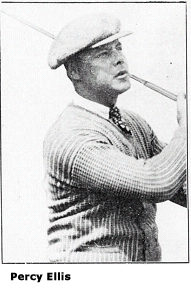|
Chapter
9. A Brush with Fame
The 1935 Open Championship was at Muirfield and the week before I
played in the inaugural Scottish Open Championship at the beautiful
Perthshire resort – Gleneagles, where most of the top British
players had assembled looking for a good ‘workout’ before the Open.
I was drawn with the Ryder Cup player, Bert Hodson (Chigwell), who
missed the cut and my partner for the final two rounds on the
Wednesday was none other than Joe Ezar, one of the few overseas
players in the field. He normally played right-handed but in the
tournament he suddenly announced – “I think we’ll play this the
other way round”, and produced a left-handed club from his bag to
play his approach on to the green. At Gleneagles he put on his show,
going through the usual trick-shot repertoire – although his patter,
copied from Kirkwood, was not quite as good as the ‘original Joe.’
He started with a hook, a slice and a straight shot (the hardest of
all to do), He would then hit a high ball; hit two balls at once and
catch one; hit a further two balls at once, one to the left the
other to the right; tee up three balls one on top of the other and
hit the centre one; play a shot left handed with a right-handers
club; hit a ball and catch it; perform clowning acts with balls. I
remember seeing him hit ten balls high into the air so rapidly that
they were all still airborne before the first one landed. I tried it
and the best I could manage was three.
Like most Trick Shot exponents Joe was not a great tournament player
but, like that other Texan, Trevino, a bet could have a dramatic
effect on his play and a substantial wager in Italian lire the
following year was to inspire him to play one of the most amazing
rounds of golf ever. That incident is described in the next chapter
and I was not there to see it, but I did witness his expertise on
the Snooker table at Gleneagles. He was near scratch at snooker and
I remember him saying to an opponent – “You can’t snooker me”, when
he was put into a very difficult position. “That’s a four-railer”,
he said and proceeded to escape via four cushions. Professionals in
snooker and golf are often good at each other’s sports. The games
require similar attributes - a steady hand, a good eye, patience and
tremendous concentration.
 In the tournament Joe and I both opened with 73s and in the second
round I shot 76 to Joe’s 75, but we were falling well behind the
joint leader, Percy Alliss, who had added a 70 to his opening course
record 67. It could have been even better but for his poor form with
the putter. Percy holed hardly anything and his frustration showed
when he quickly went to tap in a 9-incher – and missed! The
Gleneagles Assistant, W. S. Callum, shot 68 to share the lead. The
organisers must have been pleased with the standard being set, but
this was to be blunted by a rap on the knuckles received from the
R&A and published in the newspapers the following morning. In the tournament Joe and I both opened with 73s and in the second
round I shot 76 to Joe’s 75, but we were falling well behind the
joint leader, Percy Alliss, who had added a 70 to his opening course
record 67. It could have been even better but for his poor form with
the putter. Percy holed hardly anything and his frustration showed
when he quickly went to tap in a 9-incher – and missed! The
Gleneagles Assistant, W. S. Callum, shot 68 to share the lead. The
organisers must have been pleased with the standard being set, but
this was to be blunted by a rap on the knuckles received from the
R&A and published in the newspapers the following morning.
It said:
“The Championship committee of the Royal and Ancient Golf Club of St
Andrews desires to call the attention of golfers to the name of the
competition being played at Gleneagles. The so called ‘Open
Championship of Scotland’ was named without any reference to the
Royal and Ancient Golf Club and the club considers that no golf
competitions organised by private enterprise should be called by
such a misleading name. Attention having been drawn to the matter
the Royal and Ancient Golf Club hopes that in future the promoters
of golf competitions will avoid the use of the word ‘Championship’”.
Nowadays there is a more relaxed attitude to the use of the word,
but it is interesting to note that books refer to the event as the
Penfold Tournament and the1935 Scottish Open was not to be mentioned
in the Gleneagles ‘Championship’ record lists.
Percy had another 70 in round three, but the local hope, Callum,
dropped out of contention with an 81. The challenge was taken up by
Jack Busson from Pannal, who was to make his only Ryder Cup
appearance that year. Busson equalled Percy’s new course record with
a 67 to be only two behind going into the last round. He finished
with a fine 68, but Percy lowered the record again with a 66 to
finish on 273 to take the title by four shots. It was a record low
total for a tournament played on a course of significant length. [He
had peaked too early and was to finish 16th = at Muirfield]
I finished with respectable rounds of 70, 72, to be three shots
ahead of my ambidextrous partner, Joe. Perhaps he would have done
better if someone had wagered some Scottish pound notes on the
outcome of his round!
NEXT
|